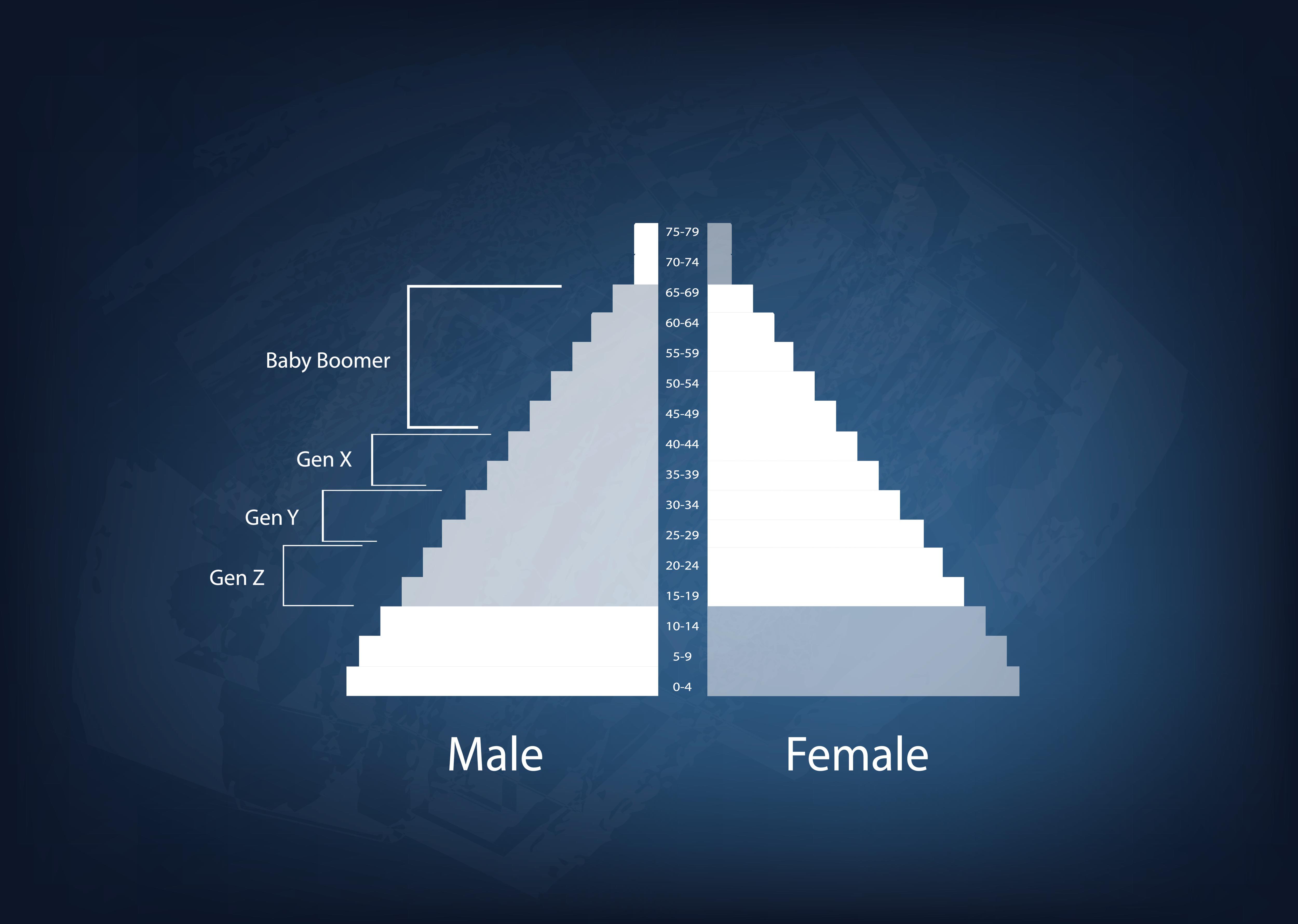
Population pyramids are a fascinating and informative tool used in demography to visualize the age and gender distribution of a population. The shape of a population pyramid can reveal a lot about a region’s demographics, including birth rates, life expectancy, and overall population trends. While population pyramids might seem like dry statistical graphs, they actually hold a wealth of surprising facts and insights about different countries and regions around the world.
In this article, we will delve into 19 intriguing and unexpected facts about population pyramids that will not only broaden your understanding of demography but also provide unique perspectives on various societies. From the impacts of fertility rates on population structure to the effects of migration and technological advancements, these facts will showcase the dynamic nature of human populations and the incredible diversity of our world.
Key Takeaways:
- Population pyramids show the age and gender makeup of a population. They help predict future workforce needs and reveal social and economic trends.
- The shape of a population pyramid can tell us a lot about a country’s stage of development and its potential challenges and opportunities.
Population pyramids are graphical representations of a population’s age and gender distribution.
Population pyramids provide valuable insights into the demographic characteristics of a population, helping policymakers and researchers understand various social and economic trends.
The shape of a population pyramid can indicate the stage of demographic transition a country is in.
A wide base and narrower top indicate a young population, while a narrower base and wider top suggest an aging population.
A “youth bulge” in a population pyramid can have significant social and political implications.
When a large proportion of the population falls within the younger age groups, it can lead to increased demands for education, employment, and healthcare services.
Some population pyramids resemble a “pyramid” shape, while others may have unique shapes like a “beehive” or “inverted pyramid.”
The shape of a population pyramid is influenced by factors such as birth rates, death rates, and migration patterns.
Developed countries often have population pyramids with a more even distribution across age groups.
Due to lower birth rates and better healthcare, developed nations tend to have a more balanced age structure compared to developing countries.
Population pyramids can help predict future workforce supply and demand.
By analyzing the size and distribution of different age groups, policymakers can anticipate future labor market needs and plan for educational and employment requirements.
The width of the base of a population pyramid indicates the birth rate.
A wider base suggests higher fertility rates, while a narrower base indicates lower birth rates.
A wide top in a population pyramid indicates a higher death rate.
An increased proportion of elderly individuals in the population suggests a higher mortality rate and longer life expectancy.
A “bulge” in the middle of a population pyramid can indicate a baby boomer generation.
The baby boomer generation refers to the significant increase in births following World War II and has had a lasting impact on population structures in many countries.
Population pyramids can help assess the potential impact of immigration on a population.
By analyzing the age and gender distribution of immigrants, policymakers can understand the potential effects on workforce composition and social integration.
Rapidly changing population pyramids can pose challenges for healthcare and social security systems.
A sudden increase in the proportion of elderly individuals can strain healthcare resources and place pressure on pension systems.
Population pyramids can vary significantly between different countries and regions.
Factors such as cultural norms, economic development, and government policies can influence the shape and characteristics of population pyramids.
The study of population pyramids is crucial for understanding population growth and its impact on various sectors.
From urban planning to healthcare provision, population pyramids provide essential information for effective policymaking and resource allocation.
Population pyramids can reveal disparities in gender imbalances.
In some societies, gender discrimination or cultural practices can lead to unequal proportions of males and females in certain age groups.
Shifts in population pyramids can indicate changing social trends and lifestyle choices.
Factors such as declining birth rates, delayed marriages, and increased longevity can all influence the shape and dynamics of population pyramids.
Population pyramids can help analyze the potential impact of epidemics and pandemics.
In times of public health crises, population pyramids can aid in understanding the vulnerability of different age groups and assessing healthcare needs.
High dependency ratios can strain economic resources and social support systems.
A high dependency ratio, characterized by a large proportion of young and elderly individuals relative to the working-age population, can lead to increased demands on social services.
Population pyramids can provide insights into migration patterns.
By analyzing changes in the age and gender distribution over time, researchers can infer both internal and international migration trends.
The study of population pyramids is essential for long-term economic planning and sustainable development.
By understanding population dynamics and predicting future trends, governments can implement effective policies to support economic growth and social well-being.
Conclusion
The study of population pyramids is a fascinating field that offers deep insights into the demographics of a region. Through the analysis and interpretation of these pyramids, we can uncover numerous surprising facts about population dynamics, social structures, and development trends. From understanding the impacts of aging populations to identifying patterns in fertility rates and migration trends, population pyramids provide valuable information for policy-makers, researchers, and businesses.By examining the shape, size, and distribution of population pyramids, we can gain valuable insights into the development and challenges faced by different countries and regions. Whether it’s the population explosion in certain regions, the rapid aging of societies, or the impacts of changing birth rates, population pyramids offer a visual representation of these demographic shifts.As we delve deeper into the world of population pyramids, the more we realize that there is so much more to discover. The interplay between factors such as education, healthcare, economic development, and cultural norms all have a significant impact on population structures.In conclusion, population pyramids are not just static graphs but windows into the past, present, and future of a population. They offer surprising and nuanced insights into the social, economic, and cultural aspects of a region, making them an invaluable tool for understanding and addressing the challenges and opportunities that come with changing demographics.
FAQs
Q: What is a population pyramid?
A: A population pyramid is a graphical representation that shows the age and gender distribution of a population.
Q: What can we learn from analyzing population pyramids?
A: Analyzing population pyramids can provide insights into factors such as birth rates, death rates, life expectancy, population growth, and the age structure of a population.
Q: How do population pyramids help in understanding social and economic trends?
A: Population pyramids can help in understanding social and economic trends by revealing patterns in fertility rates, migration rates, dependency ratios, and the aging population, which are all key indicators of a society’s development and challenges.
Q: What are some of the surprising facts about population pyramids?
A: Some surprising facts about population pyramids include the rapid aging of certain societies, the impact of declining birth rates, the changing gender ratios, and the challenges posed by a large youth population.
Q: How can population pyramids be used for planning and policy-making?
A: Population pyramids can provide valuable information for planning and policy-making in areas such as healthcare, education, social security, housing, and infrastructure, as they help in understanding the future needs and demands of a population.
Was this page helpful?
Our commitment to delivering trustworthy and engaging content is at the heart of what we do. Each fact on our site is contributed by real users like you, bringing a wealth of diverse insights and information. To ensure the highest standards of accuracy and reliability, our dedicated editors meticulously review each submission. This process guarantees that the facts we share are not only fascinating but also credible. Trust in our commitment to quality and authenticity as you explore and learn with us.


